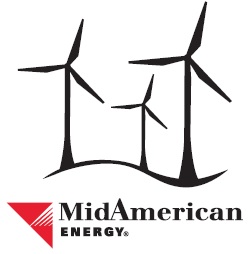 In a plan filed Aug. 30 with the U.S. Fish and Wildlife Service, MidAmerican Energy Company proposes a series of measures to help minimize how wind turbines may impact bald eagles and four bat species.
In a plan filed Aug. 30 with the U.S. Fish and Wildlife Service, MidAmerican Energy Company proposes a series of measures to help minimize how wind turbines may impact bald eagles and four bat species.
The company’s habitat conservation plan reflects insights gleaned from the most extensive research effort of its kind, spanning four years and covering most of MidAmerican Energy’s wind fleet.
The plan aims to help protect four bat species, including two that are federally protected, by modifying nighttime wind turbine operations during certain months, and making additional operational changes at four wind farms where researchers found signs of increased bat activity in the area.
The proposed changes involve adjusting a turbine’s “cut-in” speed, or the wind speed at which a turbine begins to spin and produce energy. Studies show the adjustment can minimize bat fatalities. The changes will slightly decrease electric generation output.
The plan also proposes measures to reduce impacts on bald eagles that may be present near MidAmerican Energy wind farms. It calls for training wind turbine technicians on wildlife search protocols during turbine visits, and educating landowners about removing animal remains that may attract eagles near wind turbines – reducing the odds of an eagle coming in contact with a wind turbine.
In addition to modifying wind turbine operations, MidAmerican Energy proposes to establish a $4.4 million bat conservation fund and a $1.6 million eagle conservation fund to support statewide mitigation projects to offset any impacts to those species.
The company seeks a 30-year U.S. government permit to allow for an average of 10 turbine-related incidental bald eagle “takes” – or deaths – per year across its Iowa service territory. The permit would account for less than a half percent of the eagle population that could be affected by MidAmerican Energy wind farms. The plan also calls for a take permit for four bat species.
“We understand that even though wind energy is clean and renewable, it impacts wildlife,” Jenny McIvor, vice president, environmental programs for MidAmerican Energy, said. “That’s why we’ve worked so hard and spent $15 million to study wildlife impacts at our wind facilities and tailor a conservation plan that specifically addresses those impacts.”
In November 2014, MidAmerican Energy, along with the U.S. Fish and Wildlife Service and the Iowa Department of Natural Resources, began a series of studies to determine how wind farms impact bald eagles and four bat species: Indiana, northern long-eared, little brown and tri-colored bats. The studies examined where sensitive bat species and bald eagles appear near MidAmerican Energy wind farms and evaluated impacts to these species.
The company is using information gathered through the studies to enhance conservation practices for existing wind farms and where the company places new ones.
“MidAmerican Energy is a national leader in generating wind energy,” McIvor said. “Now we’re leading on conservation efforts with this comprehensive plan, which is a gold standard for our wind portfolio and the industry.”
The U.S. Fish and Wildlife Service is expected to take final action on its draft environmental impact statement evaluating the plan by spring 2019 following a public comment period.
MidAmerican Energy wind energy leadership
MidAmerican Energy built its first wind turbine in 2004, and now operates more than 2,100 turbines at 27 wind farms across Iowa. Last year, MidAmerican Energy generated renewable energy equal to about 50 percent of its Iowa customers’ annual use, and announced plans to expand it to 100 percent by the end of 2021.
